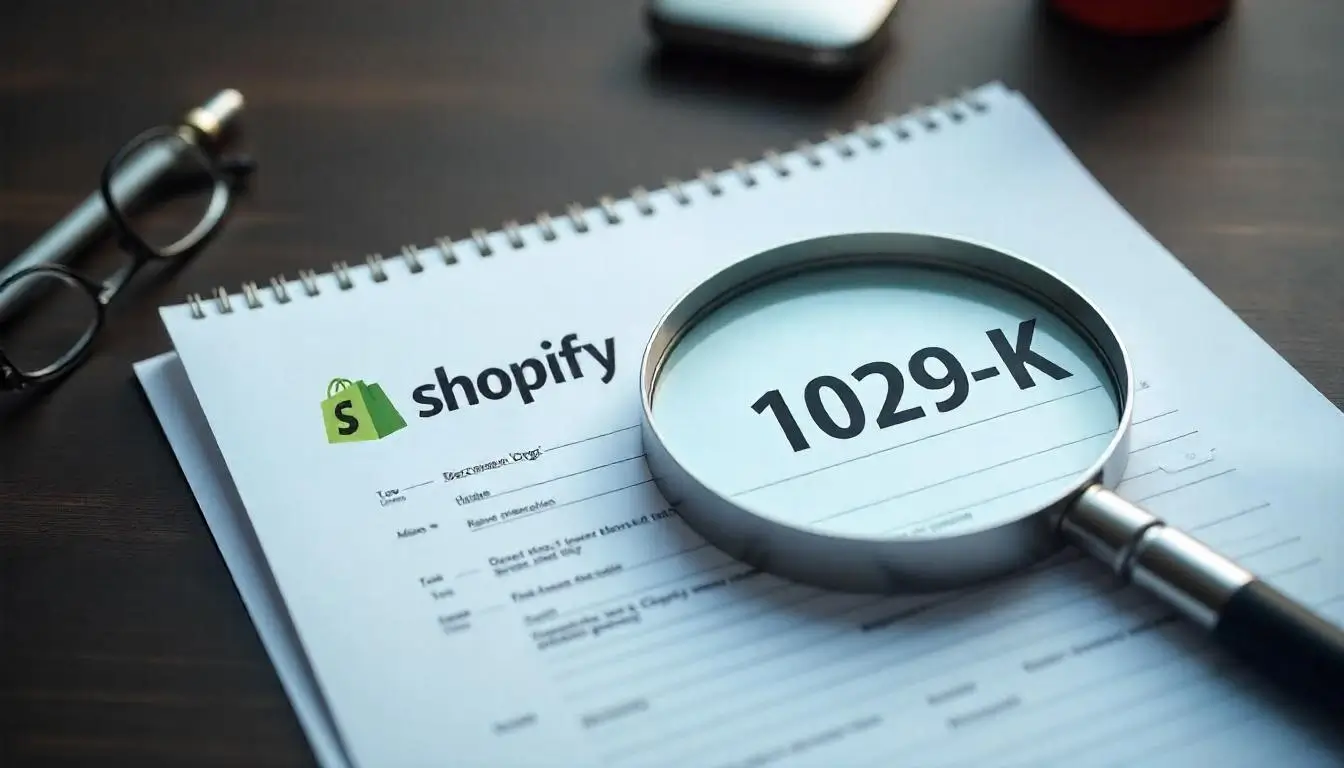In 2025, Shopify 1099k reporting rules are undergoing a major change—and it could impact every online store owner in the United States. If you’re an ecommerce seller using platforms like Shopify, Etsy, PayPal, or eBay, you need to pay close attention. The IRS is cracking down on income reporting, and missing these updates could result in hefty penalties or tax complications.
This article explains what the changes are, why they matter, and what Shopify sellers must do to stay compliant.
🧾 What Is a 1099-K Form?
A 1099-K is a tax form used by third-party payment processors (like Shopify Payments, Stripe, or PayPal) to report the gross amount of payments received by a seller over the course of a year. It’s meant to help the IRS track business income and ensure proper taxation.
Prior to 2022, the federal reporting threshold was:
- More than $20,000 in gross sales and
- Over 200 transactions
But that’s changing…
⚠️ What’s Changing in 2025?
Beginning in 2025, the IRS is enforcing a much lower threshold:
Only $600 in gross sales per year—regardless of the number of transactions.
This means:
- Even casual sellers with minimal activity will now receive a 1099-K.
- You must report this income to the IRS.
- No more “side hustle secrecy.”
Shopify will issue a 1099-K to any U.S.-based seller who receives $600 or more in gross payments through Shopify Payments.
🤔 Why Is the IRS Doing This?
The change is part of the American Rescue Plan Act passed in 2021. The goal is to increase tax compliance, especially in the gig economy and online commerce sectors. The IRS believes that many small sellers are underreporting income.
So, what does this mean for your online store?
🛒 How Shopify 1099-K Changes Affect Online Sellers
1. More Sellers Will Receive 1099-Ks
If you make over $600/year, Shopify is now required to issue the form.
2. Side Hustlers Must Report Income
Even if you sell as a hobby, you must now report income on your tax return.
3. Accurate Bookkeeping Becomes Essential
With tighter IRS scrutiny, it’s crucial to track:
- Cost of goods sold (COGS)
- Business expenses
- Refunds and chargebacks
4. You Might Owe More Taxes
Previously, casual sellers might have flown under the radar. Now, you may owe taxes—even if your profits were slim.
5. State-Level 1099-K Requirements May Differ
Some states (e.g., Massachusetts and Vermont) have their own lower thresholds.
📋 How to Prepare for the Shopify 1099-K Changes
✅ 1. Track All Transactions
Use tools like:
- QuickBooks
- Wave
- Shopify reports
✅ 2. Separate Business and Personal Finances
Open a separate bank account and credit card for your business. This simplifies tracking.
✅ 3. Keep Receipts and Expense Logs
This helps reduce taxable income and proves legitimacy in case of an audit.
✅ 4. Work With a Tax Professional
Get professional help to make sense of deductions, write-offs, and quarterly payments.
✅ 5. Review Shopify’s 1099-K Eligibility
Make sure your address, EIN, and business type are properly updated in your Shopify settings.
💬 What Shopify Sellers Are Saying (Real Reactions)
Jamie (Clothing Seller): “I had no idea selling a few tees a month could trigger a tax form. Glad I found out early!”
Erik (Tech Accessories Store): “I’ve already updated my Shopify dashboard to track taxes. The $600 rule makes it serious.”
Tina (Part-Time Crafter): “Honestly, it’s stressful. But now I’m keeping digital receipts and planning better.”
🧠 Expert Advice from CPAs
We interviewed tax experts who recommend:
- Setting aside 25–30% of your profits for tax time
- Filing quarterly taxes if your earnings exceed $1,000/year
- Keeping digital and paper backups of all financial records
🔍 Common Questions About Shopify 1099-K (FAQ)
1. Will I still get a 1099-K if I make under $600?
No. The form is only issued if you earn $600 or more through Shopify Payments.
2. Is this rule specific to Shopify?
No. It applies to all third-party payment processors—like PayPal, Venmo, eBay, and Etsy.
3. What if I sell as a hobby?
The IRS doesn’t distinguish between hobbies and businesses when it comes to income. Report it.
4. Can I deduct expenses?
Yes! Costs like materials, shipping, website fees, and advertising can reduce your taxable income.
5. What happens if I ignore the 1099-K?
You risk IRS penalties, interest, and a potential audit.
🧾 Sample Breakdown of a 1099-K for Shopify Sellers
| Category | Amount |
|---|---|
| Gross Sales | $7,500 |
| Refunds | -$500 |
| Chargebacks | -$200 |
| Net Income (before expenses) | $6,800 |
| Estimated Taxes (25%) | $1,700 |
Make sure to subtract actual business expenses to calculate net taxable income.
📌 Final Thoughts: Time to Get Serious About Ecommerce Taxes
The 2025 Shopify 1099-K update isn’t just a small rule change—it’s a wake-up call for every ecommerce seller. Whether you run a full-time online business or casually flip products for extra cash, the IRS expects you to report and pay taxes on all income.
Don’t wait until next tax season to organize your books.
With the right tools, knowledge, and maybe a good accountant, you can stay compliant and keep growing your online store with peace of mind.
Ready to take your tax game to the next level? Start tracking your Shopify income today!
- Start Earning: How to Make Money on Taobao Without Big Investment
- Can You Use PayPal on Taobao? Here’s What You Need to Know (2025 Update)
- AI vs. Manual Ecommerce Management: What’s More Effective in 2025?
- Shopify 1099-K Reporting Rules Are Changing: How It Affects Your Online Store
- AliExpress vs Amazon: Which Is Better for Budget Shoppers?
- Is AliExpress Safe in 2025? What Buyers Need to Know Today
- Why Is Pandabuy So Popular? A Deep Dive into Its Rise on Social Media
- How Safe Is Pandabuy? What Every New Shopper Should Know
- How to Use Pandabuy in 2025: Step-by-Step for First-Time Buyers
- Taobao Shipping Explained: Delivery Times & Costs in 2025
- Taobao Payment Not Working Internationally? Here’s Why
- Shopify Experts vs DIY: What’s Best for Your Business?
- Top Dropshipping Businesses to Start in 2025
- How to Use Taobao in English: A Step-by-Step Guide
- Taobao Login Issues & Link Sharing Problems: How to Fix Them
- Is Taobao Safe? What You Need to Know Before Buying
- Shogun Shopify: The Best Page Builder for Your Store
- Magento Marketplace vs Shopify: Which Platform is Best for Sellers?
- How to Hire a WooCommerce Expert: Skills, Costs, and Best Platforms
- Ecommerce Fulfillment Services: How to Choose the Best Solution for Your Business
- Ecommerce explicado: Tipos, beneficios y claves del éxito
- Ecommerce: ¿Qué es y cómo empezar tu tienda online en 2025?
- The Ecommerce Equation: Unlocking Profitable Online Sales Strategies
- Crack the Ecommerce Equation: The Formula for Success in 2025
- Retail Ecommerce Ventures: Transforming Brands into Online Success in 2025
- Ecommerce Photography Tips: Shoot Stunning Product Images Like a Pro
- Best Cameras and Tools for Ecommerce Photography in 2025
- Top B2B Ecommerce Solutions for 2025: Powering Your Business Growth
- How to Choose the Best B2B Ecommerce Solution: A Complete Guide
- Best Ecommerce Website Creators for 2025: Build Your Store in Minutes
- 5 Reasons Why Ecommdirect is a Game-Changer for Online Retailers
- EcommDirect: The Future of Seamless Online Shopping in 2025
- Connective Ecommerce: The Future of Seamless Online Shopping
- Top Ecommerce Web Development Services in Melbourne for 2025
- Ecommerce Web Development Melbourne: Build a High-Converting Online Store
- Top Tips for Choosing the Right Ecommerce Advertising Agency
- Why Every Online Store Needs an Ecommerce Advertising Agency
- Boost Your Sales with the Best Ecommerce Advertising Agency in 2025
- Magento vs. Other Ecommerce Platforms: Which is Best for Your Store?
- Top Features of the Magento Ecommerce Platform You Need to Know
- How to Boost Sales with the Magento Ecommerce Platform
- Top Ecommerce SEO Experts: Boost Your Online Store Traffic
- Why Hiring Ecommerce SEO Experts Is a Game-Changer for Your Store
- Ecommerce Website Development in Dubai: Build Your Store for Success
- Protect Your Online Store with the Right Business Insurance
- Top Insurance Options for Ecommerce Entrepreneurs
- Taobao Shopping Made Easy: Tips for Global Buyers
- Ecommerce Business Insurance: Why It Matters in 2025
- Why Ecommerce Business Is the Best Startup Option Today
- Ecommerce Business Marketing Strategies That Drive Sales
- 10 Common Mistakes to Avoid When Starting an Ecommerce Business
- The Future of Ecommerce Business: Trends to Watch in 2025
- Ecommerce Business Essentials: Tools, Tips, and Strategies for Beginners
- Top 10 Ecommerce Business Ideas to Boost Your Revenue This Year
- How to Start a Successful Ecommerce Business in 2025: A Step-by-Step Guide
- Unlock the Power of Odoo Ecommerce: The Ultimate Solution for Your Online Store
- Expert Ecommerce Website Development Services for Your Store
- Expert Guide to Ecommerce Website Development in Dubai: Build Your Dream Online Store
- Top eCommerce Website Development Companies: Build Your Dream Online Store Today
- Streamlining E-commerce Product Updates with GitHub Workflows
- Monetize Your E-commerce Open-source Projects: A Beginner’s Guide to GitHub Sponsors
- Collaborating with Freelancers on GitHub for E-commerce Projects
- The Role of GitHub in Supporting Multi-language E-commerce Sites
- Using GitHub Actions for E-commerce SEO Audits
- Creating and Managing API Documentation for E-commerce Platforms on GitHub
- Mastering Ecommerce Website Development with GitHub: Tools, Tips, and Best Practices
- Optimizing E-commerce Performance with GitHub Monitoring Tools
- Top GitHub Integrations for Streamlining E-commerce Development and Operations
- Managing Ecommerce Data with GitHub and Git LFS
- Version Control for E-commerce Teams: A Guide to Using Git and GitHub.
- Using GitHub Projects to Manage E-commerce Site Development
- Top GitHub Repos for Enhancing Security on Your E-commerce Site
- Securing Your E-commerce Codebase: Managing Access and Permissions in GitHub
- Managing E-commerce Data with GitHub and Git LFS
- Leveraging GitHub Pages for a Minimalist E-commerce Store


